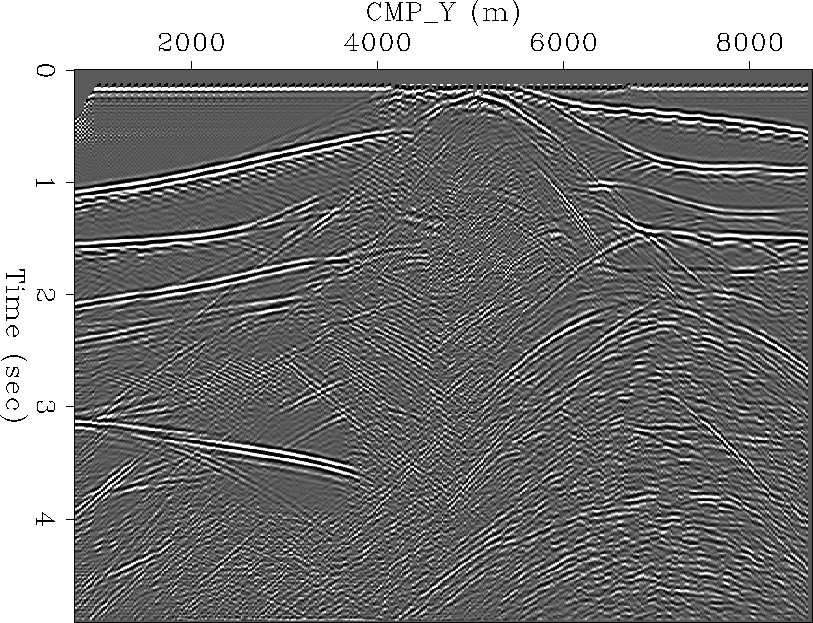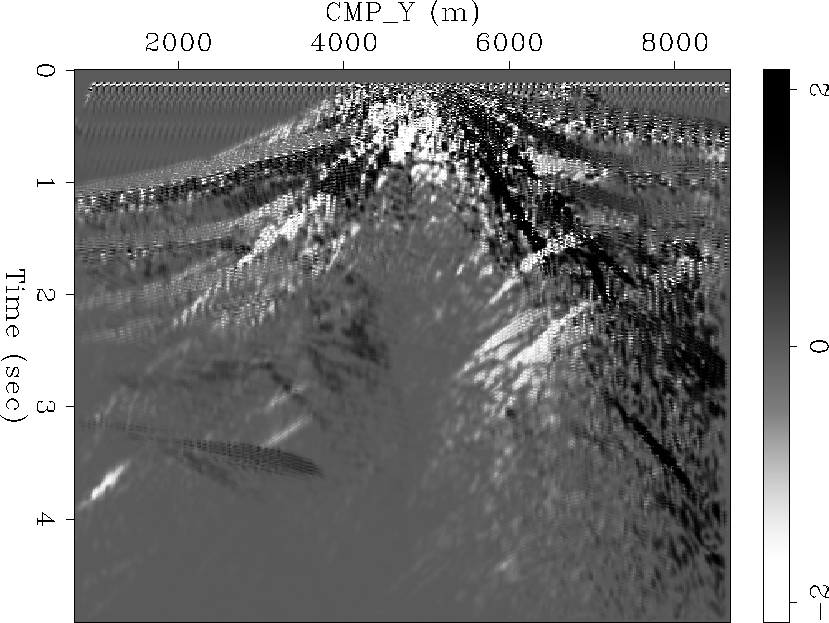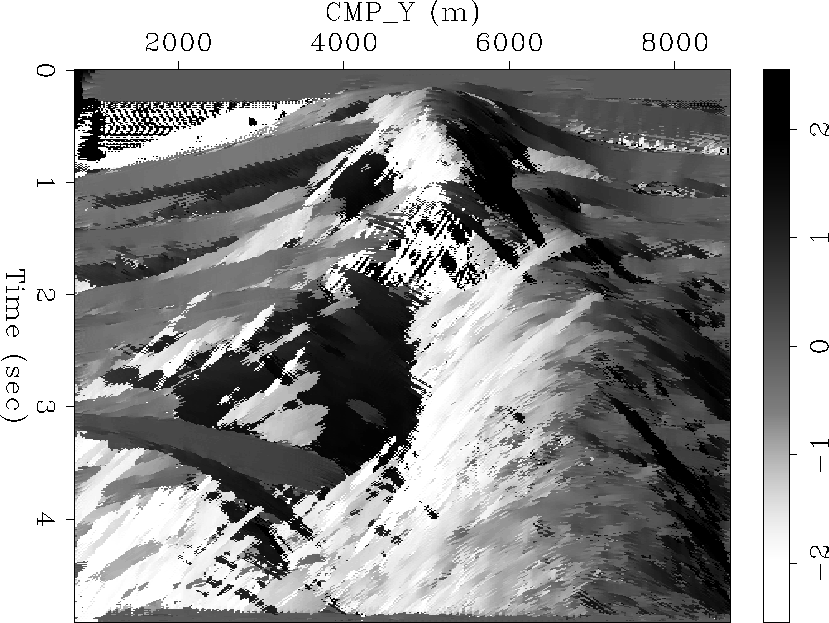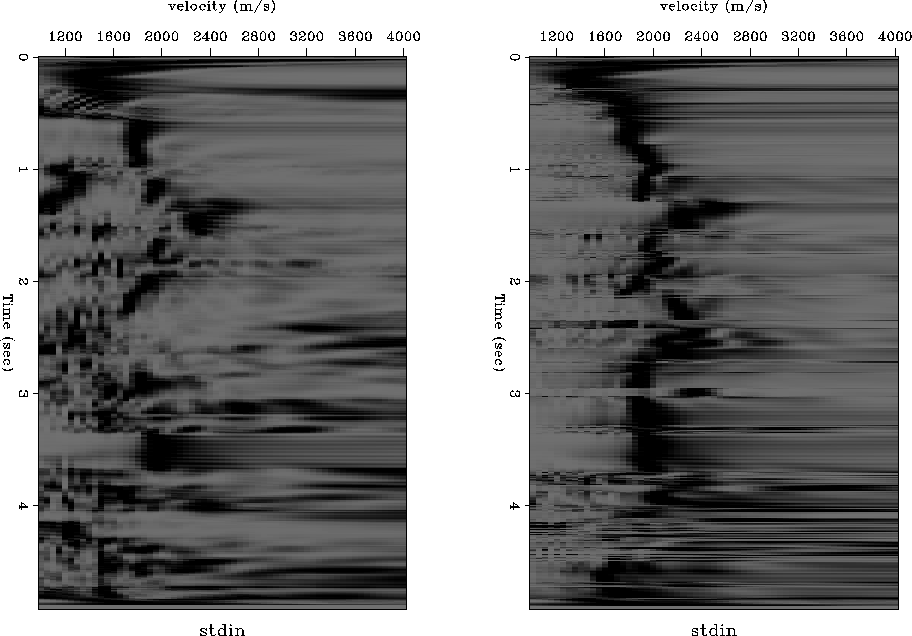




Next: Land example
Up: Günther: Dips for super-gathers
Previous: CRS Stack
Stable estimate of dips in the stacked zero-offset or migrated section are required in order to make super-gather corrections. Typical results of such dip scans are shown for an inline of the SEG/EAGE Salt model (Figure ![[*]](http://sepwww.stanford.edu/latex2html/cross_ref_motif.gif) ). Claerbout (1992) introduces plane-wave deconstruction filters that locally decompose an image into plane waves, and Fomel (2002) extends the concept to a least-squares method for continuously decomposing an image into dips. Figure (
). Claerbout (1992) introduces plane-wave deconstruction filters that locally decompose an image into plane waves, and Fomel (2002) extends the concept to a least-squares method for continuously decomposing an image into dips. Figure (![[*]](http://sepwww.stanford.edu/latex2html/cross_ref_motif.gif) ) shows the result of applying this algorithm to the 2D stack image. A semblance scan provides an alternative--and somewhat simpler--method for computing dips. This method is identical to CRS post-stack parameter estimation Jäger and Hubral (2001). At evenly spaced locations in the stack, a grid search maximizes semblance across circular slices through the volume for different values of the dip
) shows the result of applying this algorithm to the 2D stack image. A semblance scan provides an alternative--and somewhat simpler--method for computing dips. This method is identical to CRS post-stack parameter estimation Jäger and Hubral (2001). At evenly spaced locations in the stack, a grid search maximizes semblance across circular slices through the volume for different values of the dip  . For 3D data, the search iterates over both x- and y-components of the dip, so it can be expensive to finely sample the search space. A staged search strategy can help overcome this problem by first determining coarse dip estimates and then iteratively refining the results with finer search grids. Figure (
. For 3D data, the search iterates over both x- and y-components of the dip, so it can be expensive to finely sample the search space. A staged search strategy can help overcome this problem by first determining coarse dip estimates and then iteratively refining the results with finer search grids. Figure (![[*]](http://sepwww.stanford.edu/latex2html/cross_ref_motif.gif) ) shows the dip section from the semblance scan.
seg_inline
) shows the dip section from the semblance scan.
seg_inline
Figure 2 An inline from a zero-offset stack of the SEG/EAGE Salt model.




 fomel_dips
fomel_dips
Figure 3 Dips computed for the SEG/EAGE Salt model after Fomel (2002).




 semb_dips
semb_dips
Figure 4 Dips computed for the SEG/EAGE Salt model using a semblance scan.




 seg_vel_pan
seg_vel_pan
Figure 5 Velocity panel for a 5x5 super-gather computed without dip corrections (left) and with dip corrections (right). The dip corrections improve the coherence of the semblance peaks and make the panel easier to pick.





Figure (![[*]](http://sepwww.stanford.edu/latex2html/cross_ref_motif.gif) ) shows velocity spectra computed on a super-gather from the salt model. The gather contains data from 5 inlines and 5 crosslines, and the spectra are computed with NMO (left) and with the dip corrected move-out (right). While this example shows that dip corrections can improve the quality of semblance panels for super-gathers, it does not motivate the need for super-gathers. Since the salt model does not contain noise, a perfectly adequate velocity spectrum can be computed from a single CDP. But in real data, especially land datasets, noise is a major impediment for velocity analysis. The next example tests the correction on a 3D land dataset. The data were collected with 25m spacing in both the in-line and cross-line directions in a region with complex geology characterized by salt intrusions. With an average fold of 25, noise is a significant problem for velocity analysis.
) shows velocity spectra computed on a super-gather from the salt model. The gather contains data from 5 inlines and 5 crosslines, and the spectra are computed with NMO (left) and with the dip corrected move-out (right). While this example shows that dip corrections can improve the quality of semblance panels for super-gathers, it does not motivate the need for super-gathers. Since the salt model does not contain noise, a perfectly adequate velocity spectrum can be computed from a single CDP. But in real data, especially land datasets, noise is a major impediment for velocity analysis. The next example tests the correction on a 3D land dataset. The data were collected with 25m spacing in both the in-line and cross-line directions in a region with complex geology characterized by salt intrusions. With an average fold of 25, noise is a significant problem for velocity analysis.

![[*]](http://sepwww.stanford.edu/latex2html/cross_ref_motif.gif) ). Claerbout (1992) introduces plane-wave deconstruction filters that locally decompose an image into plane waves, and Fomel (2002) extends the concept to a least-squares method for continuously decomposing an image into dips. Figure (
). Claerbout (1992) introduces plane-wave deconstruction filters that locally decompose an image into plane waves, and Fomel (2002) extends the concept to a least-squares method for continuously decomposing an image into dips. Figure (![[*]](http://sepwww.stanford.edu/latex2html/cross_ref_motif.gif) ) shows the result of applying this algorithm to the 2D stack image. A semblance scan provides an alternative--and somewhat simpler--method for computing dips. This method is identical to CRS post-stack parameter estimation Jäger and Hubral (2001). At evenly spaced locations in the stack, a grid search maximizes semblance across circular slices through the volume for different values of the dip
) shows the result of applying this algorithm to the 2D stack image. A semblance scan provides an alternative--and somewhat simpler--method for computing dips. This method is identical to CRS post-stack parameter estimation Jäger and Hubral (2001). At evenly spaced locations in the stack, a grid search maximizes semblance across circular slices through the volume for different values of the dip ![[*]](http://sepwww.stanford.edu/latex2html/cross_ref_motif.gif) ) shows the dip section from the semblance scan.
) shows the dip section from the semblance scan.




![[*]](http://sepwww.stanford.edu/latex2html/cross_ref_motif.gif) ) shows velocity spectra computed on a super-gather from the salt model. The gather contains data from 5 inlines and 5 crosslines, and the spectra are computed with NMO (left) and with the dip corrected move-out (right). While this example shows that dip corrections can improve the quality of semblance panels for super-gathers, it does not motivate the need for super-gathers. Since the salt model does not contain noise, a perfectly adequate velocity spectrum can be computed from a single CDP. But in real data, especially land datasets, noise is a major impediment for velocity analysis. The next example tests the correction on a 3D land dataset. The data were collected with 25m spacing in both the in-line and cross-line directions in a region with complex geology characterized by salt intrusions. With an average fold of 25, noise is a significant problem for velocity analysis.
) shows velocity spectra computed on a super-gather from the salt model. The gather contains data from 5 inlines and 5 crosslines, and the spectra are computed with NMO (left) and with the dip corrected move-out (right). While this example shows that dip corrections can improve the quality of semblance panels for super-gathers, it does not motivate the need for super-gathers. Since the salt model does not contain noise, a perfectly adequate velocity spectrum can be computed from a single CDP. But in real data, especially land datasets, noise is a major impediment for velocity analysis. The next example tests the correction on a 3D land dataset. The data were collected with 25m spacing in both the in-line and cross-line directions in a region with complex geology characterized by salt intrusions. With an average fold of 25, noise is a significant problem for velocity analysis.